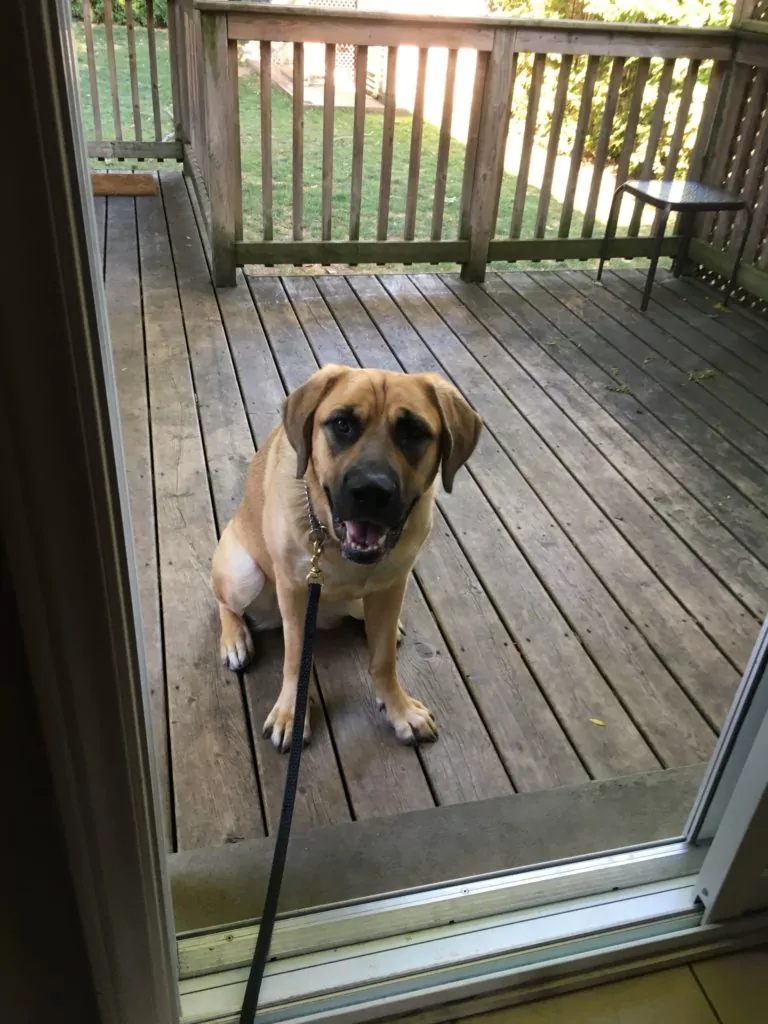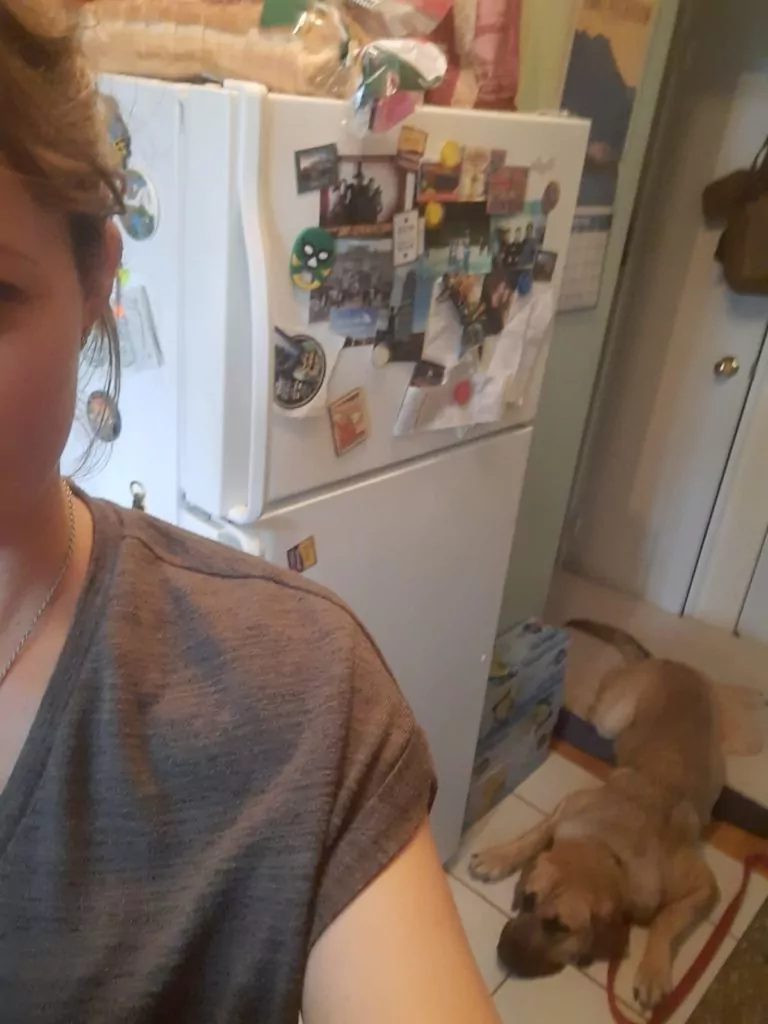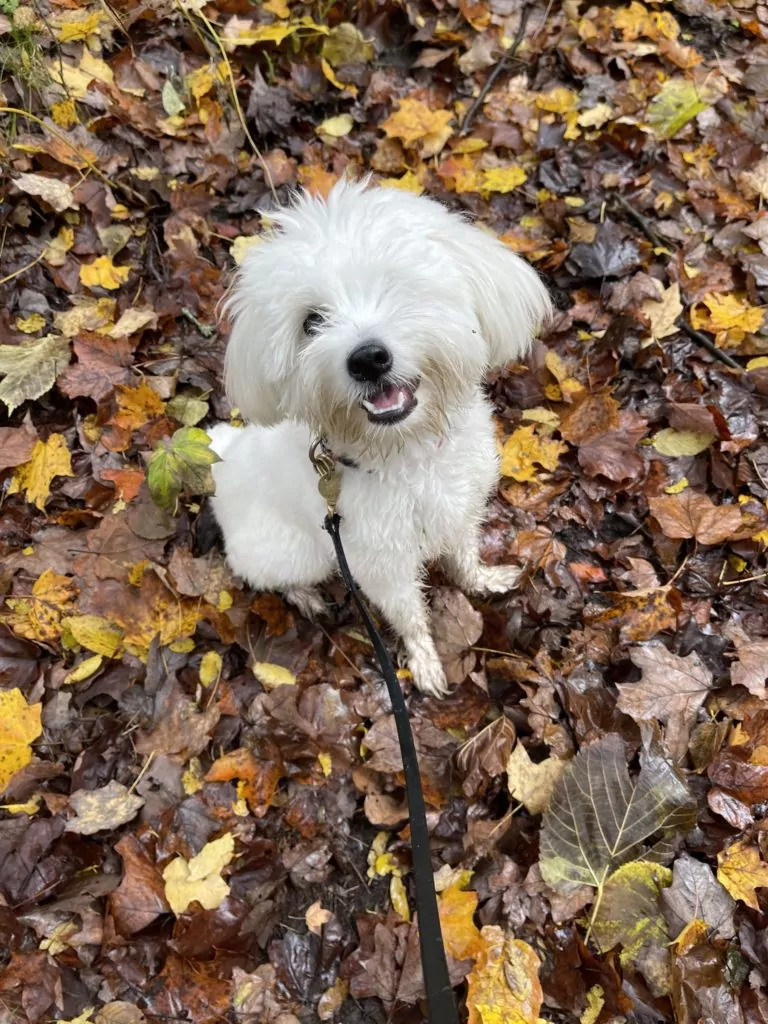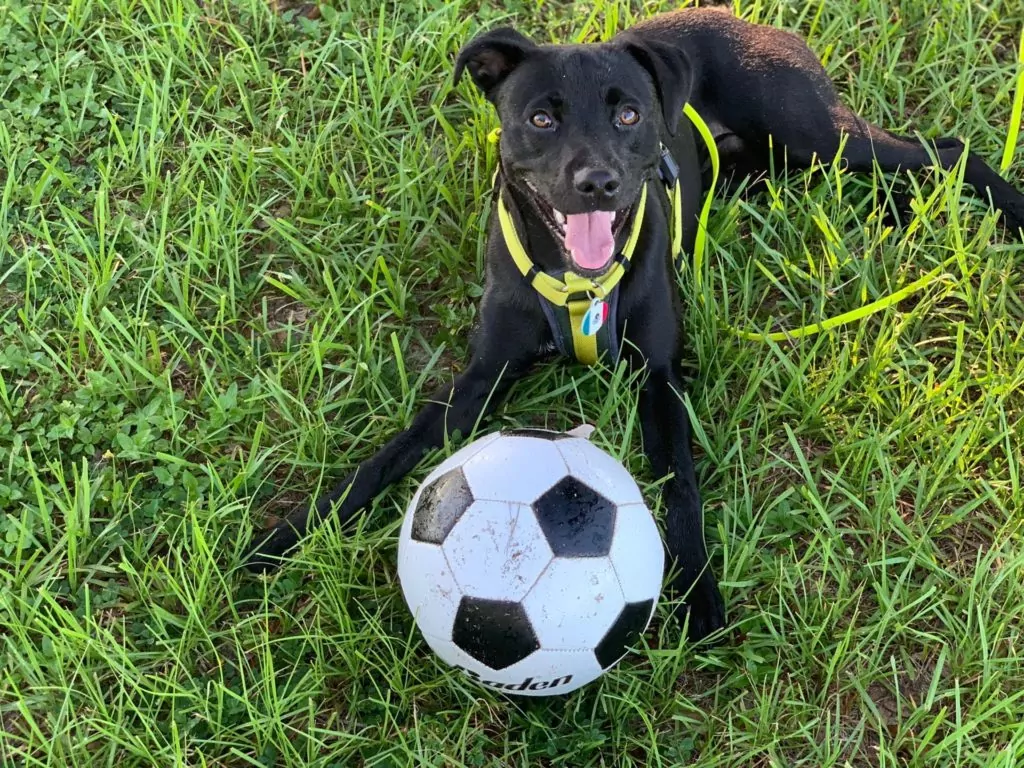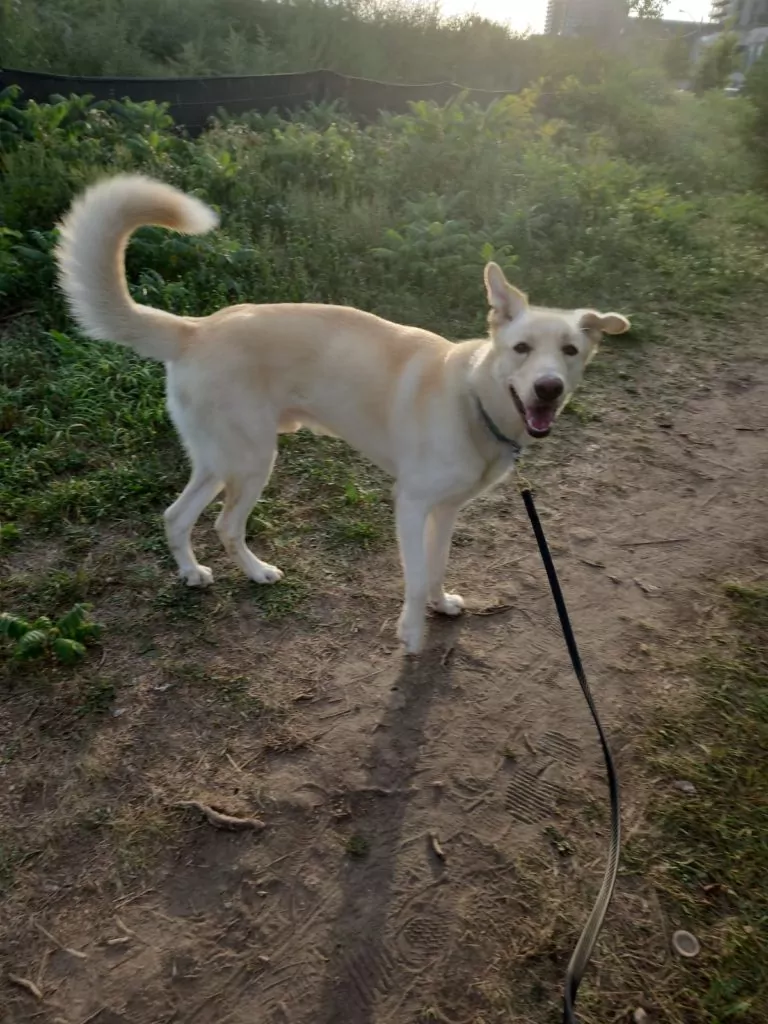Client Cases
Stella the Mastiff Mix Rescue – A Powerhouse of a Dog
Introducing Stella the Mastiff. Stella’s folks, a young couple with their heart in the right place but little experience with dogs, came to WOLDT alarmed at the growing challenges they were experiencing managing their big girl.
At a little under a year old and 110 lbs. and counting, Stella was terribly hard to handle. She’d bite the leash and drag her people out the apartment, through the corridors of their condo building, into busy elevators, and out into the crowded streets of downtown Toronto.
Some people nearby made things even more challenging for my clients. Drawn to Stella’s size and sweetness, they added fuel to the fire by constantly wanting to “say hi,” often without checking with her humans and causing Stella to pull towards them. My clients were also under the impression that this kind of “socialization” was a good thing, because they’d read so much on the internet about the importance of socializing dogs, particularly rescues like Stella.
Things took a worrisome turn when Stella started to mouth and grab their arms, and they began to wonder whether this meant they had an aggressive dog on their hands.
So we went to work at the practical level – structuring Stella’s daily life, governing her social interactions, and handling her size kindly, safely, and effectively. As an FYI, this did not involve the use of tools such as choke chains, prong collars, e-collars, or head halters. Rather, it involved coaching my clients on handling with power and poise, in a way that helped the dog settle and care to stick around. Power rather than force.
We also went to work at the conceptual level, working towards a better understanding of the differences between healthy socialization and the unfettered greeting and touching of dogs that people these days call socialization. It meant appreciating that successful socialization requires that our dogs trust us first.
It wasn’t long before Stella responded positively to the change in handling and attitude. I knew the moment I met her how stable and sweet she was, only she wasn’t sure she could let herself be that way whereas now she can.
Not long ago, my clients had the opportunity to move out of the city and while out on a walk one day, they received a fantastic compliment from a stranger. The woman said she could see how “good-natured and bonded” Stella was and that it was “nice to see someone who is well suited to having a dog have one.”
Now that is a compliment!
Client Testimonial
We approached Souha when we were feeling overwhelmed and out of our depth with our very sweet, but ungovernable, mastiff mix rescue. Souha’s advice was immediately helpful and gave us the knowledge and tools to stop fretting and struggling. Our dog became calmer and better integrated into our lives over a short span of time as we worked with Souha. As Souha will tell you, her approach is not predicated on dog tricks, but predicated on building a deeper bond with your animal through practical routine and lifestyle changes. The behaviour aspect falls into place.
Souha was incredibly generous with her time and knowledge, and always reachable. She encouraged regular updates on our progress. There was never a doubt in our minds that Souha cared as much about our dog’s welfare and happiness as we did. I have little doubt that working with Souha and implementing her advice will show exponential improvements in behaviour and relationship with your dog. We plan on returning to Souha to continue to work our way up through the different stages of socialization and integration with our dog. We would highly recommend her services.
Chelsea the German Shepherd Puppy – Going Back to Foundations After a Rocky Start
Is it possible for puppies to exhibit behavioral issues? Sadly, it is. Our client Chelsea the German shepherd was less than three months old when her owners contacted us about her behavior. Yes, they were dealing with typical puppy issues such as grabbing, chewing, getting into things, and difficulties with house-training.
However, it was Chelsea’s dismal lack of confidence, extreme timidity, sound reactivity, and extreme stranger danger that they were rightfully worried about. Even in their quiet suburban neighborhood, Chelsea could not be outside without fiercely reacting to sounds. She also scarfed down her food so quickly that she often regurgitated it.
We began deconstructing Chelsea’s way of life, going over everything her owners did the moment they walked away with her from the breeder’s property. Theirs is a common story: a young and serious couple are set on a particular breed, do their homework, locate a reputable breeder, and come home with their new friend. Understandably thrilled with their new addition, they were hardly contained their excitement, doted on the pup, and did more with her than what was appropriate at this stage. This, combined with the sensitive genetics of her pedigree, was enough to send Chelsea over the top.
My clients were relieved to know they could go back to basics to fix things and quickly adjusted their mindsets. They were reminded of the nature of puppies who are young, vulnerable, and ignorant. They understood that Chelsea wasn’t to be disciplined, only managed, redirected, and praised. They realized that manners are not the first thing we work on; rather, they are the result of a healthy way of life. The owners fundamentally got the importance of managing the environment as opposed to trying to control the puppy, who has no self-control.
Working together, we modified the manner of crating, set a schedule, and gave Chelsea time in the yard by herself. My clients quickly noticed that Chelsea became less interested in what was happening in the neighborhood than in what her owners, who were inside, were up to. That’s exactly the idea behind “solo time.”
Chelsea’s schedule also comprised outings for play, exercise, and socialization with the family. My clients learned to remain neutral any time Chelsea would nip at them while praising her for working for food and biting on tugs. They also set up a crate in their SUV and began taking Chelsea on car rides each time they went to run errands. She barked at things profusely at first, was ignored, and eventually came around to ignoring things in the car. With time, they began hanging out and working with Chelsea in their front yard, witnessing all sorts of things from a safe distance.
By being both challenged and tightly managed, Chelsea began showing improvements. She is now a secure teen showing the very soundness, strength, and spiritedness we want to cultivate in our dogs. Her body has grown beautifully and the ease in her psychology shows in the fluidity of her movements. While she continues to be a sensitive dog, she now has the wits to think before she reacts.
In the last session of our course together, after a barky introduction, Chelsea was able to join my girls Bruna and Nejra on a hike. My girls did a fine job of ignoring her, knowing she had to work past her insecurities. I said to the clients that this wasn’t just Nejra and Bruna making it happen; this was all the work my clients had done understanding and managing Chelsea which made this possible.
My clients were given the gift of knowing how to design a way of life that makes sense for where they and their dog were at in the process. They got the essence of this approach, which is simply about strengthening dogs by exposing them to things gradually. Watch this video for more about Chelsea!
Client Testimonial
Chelsea is our first dog ever and not everything started in the way we wanted. So, we desperately went into contact with dog trainers. Among all conversations we had, the one with Souha was the most meaningful and helpful, and we felt that we have already learned a lot from that ten-minute phone call. With her expertise in getting along with Shepherds, we did not hesitate to proceed with the training with her.
Along the journey with Souha, both Chelsea and I have grown so much. Dog training isn’t about the trainer training the dog nor the trainer mandating the owner how to do everything. Souha has shown us that to develop a healthy relationship eventually or to maintain a good status, we need to study the logic of training and reflect on the situation in daily life. What’s more important is consistency in training. We lost count of how many times Souha has used the word “consistency” in chat and in sessions.
We have accomplished so much under the guidance of Souha, and we are so proud of Chelsea and ourselves.
Bean – The Shi-Tzu/Havachon Puppy
My client didn’t have much experience with dogs but had dreamed of having one since childhood. Finally, she settled on a breed suited to apartment living, saved up enough for a puppy, and read and researched all she could. But when she brought home Bean, her new Havanese–shih tzu mix puppy, she found herself at a loss about what to do.
She’d had Bean for three days when we spoke. I remember how upset she sounded as she tearfully described Bean as agitated and averse to her attention. Apparently, he had nipped her several times in the span of a few short days. My client was heartbroken, thinking Bean didn’t love her.
I explained to my client that he simply did not know her yet and that all dogs need a little time to get adjusted to their new living situation. They do not know how much we love and care for them; we’re still strangers at this point. In the beginning, things need to be done a certain way to avoid having behavioral issues down the road. I also explained that we can always go back to these foundations, improve on them, and get back up again.
My client felt awful that she did not realize something as obvious. I reassured her that she certainly was not alone. The practice of bringing new dogs home without giving them the benefit of a decompression period is common and responsible for many of the problems experienced later. She happened to call three days in, but others call three months or three years in, not seeing the connection between how they got started and what they’re now dealing with.
Once over her initial turmoil, my client went to work with Bean to set him up on the right foundations. Her stance shifted to raising Bean, who is now a happy, playful, and outgoing companion. Among other things, he has coped well with losing one of his eyes, and when his owner had to go out of town and left him with me for a weekend, he took it in remarkable stride. I told her that he won the prize for the best-behaved dog I ever boarded. Such is the power of healthy puppy foundations.
Client Testimonial
I initially reached out to Souha shortly after getting a puppy who was also my first dog. I was quickly overwhelmed and more importantly, I wasn’t sure if I was making the best decisions for my dog. After speaking with Souha on our first call, I already felt more confident in the direction I was going.
Souha is incredibly knowledgeable and passionate about her work. Her guidance and advice have transformed my relationship with my dog. While he is still young, Souha has helped me build a strong foundation for him to flourish in. As he continues to grow and learn, our hard work is evident in his confidence, attitude and behavior. Souha is not only a capable trainer but an excellent mentor. She gives me confidence that I’m doing the right thing by my dog and that I can handle the various hardships that come with raising a puppy. She’s given me that confidence since our first meeting.
One of my favourite things about working with Souha is that she very clearly cares about her clients, both human and dog but particularly dog. She goes above and beyond to do what she feels is necessary for the dog’s benefit and constantly makes herself available to answer any questions or concerns I may have. She’s not always going to tell you what you want to hear, but everything she does is for the betterment of you and your dog’s relationship. I highly recommend Souha as a trainer and as a mentor. Especially if you find yourself struggling with your first dog, Souha’s vast experience and knowledge is invaluable.
Taco the Mexican Street Dog – Raising an Orphaned Puppy
I am lucky that former clients who resonate with my work often refer me to their friends. That is how I met this client, a fiery young lawyer now residing in the U.S. Soon after she rescued her new puppy Taco, an orphaned pup rescued from the streets of Mexico, she reached out to me to begin our work.
I was thrilled for her, knowing she would be the kind of person who would do right by her dog. However, concern creeped in as I continued reading her message, wherein she described life with her new puppy in ways that set off alarm bells. Her new pup was apparently “a total gem” who “follows her everywhere.” She also described him as “easygoing” and that he was already interacting with the other dog in the house, a 14-year-old German shepherd.
New dogs shouldn’t be following us around, nor do I have them meeting or interacting with the other dogs in the house, especially if these other dogs happen to be geriatric and deserving of their space. One could already see the signs of overattachment, which didn’t bode well for Taco’s capacity to grow into a sound and strong dog.
Even though the less-than-ideal conditions lasted only a few weeks, they still took their toll on the very young and impressionable pup. My client had to repair her foundations before doing much more. Taco was restless and unable to settle himself or enjoy the deep sleep so endearing of puppies. Getting him engaged in anything was a challenge. His drive for food was low and he had little interest in playing with toys, tugging, or chasing a ball.
On their walks, he was oblivious to his owner and obsessed with whatever the ground offered. Keeping him from devouring food and garbage they passed on the street caused battles. Whenever she did manage to get him engaged in play or to go on a walk, it rapidly escalated to Taco relentlessly nipping her body and tearing her clothes.
We began working together remotely, addressing all aspects in the way of life including the pup’s schedule, socialization, and daily manner of handling, bringing things back to a place of safety and simplicity. In these early days, she crated Taco heavily, giving him the chance to settle himself, let his guard down, and fall asleep, catching up on weeks of insufficient rest.
She dialed down exposure, realizing that “the abundance of socialization experiences with dogs, people, and kids” was the very reason he’d become skittish and apprehensive about socializing. Now, she built a bubble around him, teaching him to see things near and far and ignore them. She kept their outings simple, managed his food intake, revved up his physical exercise to awaken his food motivation.
As Taco began to ease up and mature, she knew she could start expanding his social circle. She built rapport with other dog owners, creating a network for herself and Taco who was better able to socialize now, as his confidence grew, knowing that anything his owner showed him was safe and good.
Taco has matured into a sound and open young dog. He has taken on major challenges with his owners, including relocating to another state, flying crated in cargo as if it were nothing. As she’s transitioned into the adolescent stage with him, she is now able to expand his world and engage full-on in sport. She has noted an elevation in the drive and power he brings to working for food, tugging, and engaging with her in ways he hadn’t before. To keep harnessing his growing energy, she located a facility to pursue scent work and agility, and they also share a life of outdoor adventures. Now, she proudly calls him a “go-anywhere, do-anything” dog.
Client Testimonial
The conventional ideas of dog training are exclusively focused on reinforcing and modifying behavior, and they are quick to label a dog's behavior as characteristics of its personality, breed, or past experience. This book takes the dog out of the behaviorist petri dish and challenges people to build a relationship with their dog in a way that aligns with a dog's nature and instincts. The result is that you no longer have to teach the dog what to do or not to do, the dog just knows.
Tobey the Siberian-Labrador Mix – Anxiety, Separation Anxiety, and Extreme Power
Introducing client Tobey, a Siberian-Labrador mix a little under two years old, who’s recently come our way with concerns surrounding separation anxiety. Like many of us, his owner shifted to working from home during the lockdowns of 2020. Being a fit and active person, she hiked daily during these times and thought that a dog could share her active lifestyle and her enjoyment of being out in nature. Soon enough, she brought home Tobey who was a young pup at the time. Under lockdown conditions, my client, her partner, and Tobey spent much of the time exclusively together.
Like many dog owners, new as well as experienced, my client developed strong feelings of attachment towards Tobey because of spending so much time with each other. At about a year old, Tobey began to act up when left alone and complaints from building management streamed in.
My client and her partner tried working on Tobey’s increasing separation anxiety but unfortunately, they parted a few months later. The change was difficult for both my client and Tobey and left her having to deal with his issues on her own.
Luckily, she didn’t wait to reach out to us. The Way of Life™ approach, which sees separation issues as reflecting a lack of maturity in the dog and in the human-dog bond, resonated with her. She’d tried what she could, including a bark collar, a camera, and having family members or pet sitters come stay with Tobey whenever she had to be away. Now, she’s learning that she must go deeper into the nature of their relationship, realizing that she too had to change.
Already, we’re seeing a marked decrease of anxiety in Tobey. A large and powerful dog, he’s now more manageable when they’re out and about. At home, he’s calmer and increasingly capable of being on his own. We look forward to continuing our work together, helping these two enjoy the relationship they were meant to have.


